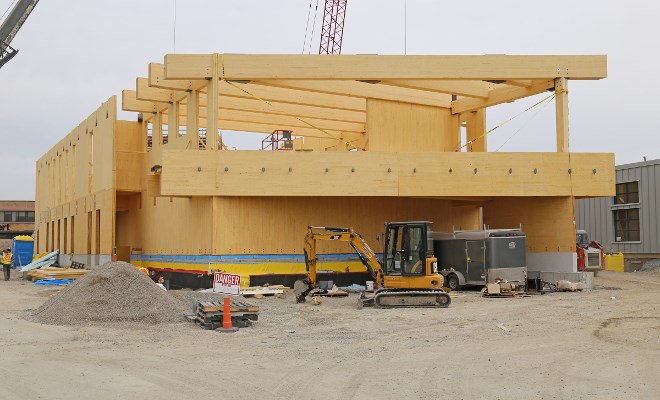Ontario’s forest products industry is welcoming the government’s move to allow mass timber buildings to reach greater heights.
The Ministry of Municipal Affairs and Housing said it will be amending Ontario’s Building Code in the coming months to permit for construction of these buildings to be upsized from its current 12 storeys to 18.
Steven Street, the executive director of WoodWorks Ontario, a wood construction advocacy group,, applauded the decision taken by Ministry of Municipal Affairs and Housing.
“Increasing the height of mass timber construction up to 18 storeys will enable low-carbon, advanced wood construction solutions to have a greater role in achieving our housing targets,” Street said in an emailed statement.
“The move will also support greater adoption of industrialized approaches, utilizing factory-built benefits that can expedite the supply of critical infrastructure in a sustainable way.”
Ontario first permitted the use of wood-framed buildings in 2015 in allowing construction, initially, of up to six storeys.
Successive provincial governments have been supportive of this type of advanced wood construction as an environmentally-friendly means to build homes faster and reduce costs, while supporting the forest products sector.
Approximately 150 mass timber projects have been completed, are under constructed, or are being planned.
With accelerated construction and home building a key tenant of the Ford government, boosting the height of wood buildings is something Municipal Affairs and Housing Minister Paul Calandra said he could get behind.
“As we work to cut red tape in order to increase housing supply, we’re taking an innovative approach to help our partners get shovels in the ground.”
In a news release, the ministry said Encapsulated Mass Timber Construction offers an environmental solution for quieter and faster construction with the same fire and structural protection as other building methods.
The building method in mass timber construction allows for more prefabricated factory-made housing that can be transported in sections to a building site and assembled in modular form. In many cases, smaller buildings can be easily and rapidly constructed within a matter of days.
Rick Jeffery, Canadian Wood Council president-CEO, congratulated the government for taking a leadership role to supporting the industry.
“These expanded provisions for mass timber will enhance the innovation already happening in the province, offering designers, developers, and municipalities the opportunity to pursue high performance, low-carbon wood construction in a greater number of buildings,” he said by email.
“The use of Encapsulated Mass Timber Construction in buildings up to 18 storeys tall has tremendous potential to expedite the delivery of essential housing while simultaneously fortifying the Ontario economy. By harnessing Ontario forest products and labour, we not only meet critical housing needs, but also empower local industries and workers, fostering economic resilience and sustainability within the province."
‘Mass timber’ refers to manufactured wood products that meet similar structural, fire protection and seismic performance as materials traditionally used to construct tall buildings, such as concrete and steel.
Encapsulated means that the manufactured wood components are covered with fire-rated treatments, like drywall.
Mass timber was mentioned in the government’s forest sector strategy.
In a statement, Natural Resources and Forestry Minister Graydon Smith said Ontario’s abundant natural resources and the skill of the industry’s workforce will meet the current demand for housing.
“Advanced wood construction will help bring long-term investments to northern communities that will create new, good-paying jobs while increasing housing supply and supporting Ontario’s largest renewable natural resource sector.”




